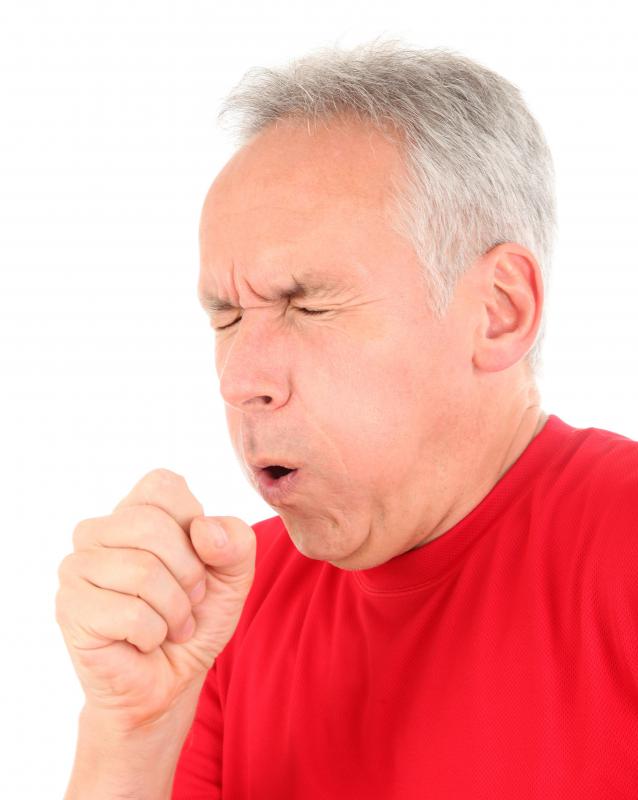At WiseGEEK, we're committed to delivering accurate, trustworthy information. Our expert-authored content is rigorously fact-checked and sourced from credible authorities. Discover how we uphold the highest standards in providing you with reliable knowledge.
What are the Symptoms of the 100 Day Cough?
The 100 day cough, or whooping cough, begins with symptoms that are sometimes mistaken for a mild cold. The illness routinely progresses through an introductory catarrhal period, a paroxysmal coughing period, and a recovery period. Severe spasms may accompany the bouts of coughing, and many vomit or feel very weak after the coughing temporarily subsides. Early treatment with antibiotics may shorten the length of the illness, but most people can expect the 100 day cough to last anywhere from two to seven weeks.
During the introductory catarrhal phase, the first symptoms usually noticed are a slight fever and a runny nose. A sore throat then develops and a non-productive hacking cough begins. Sneezing and nasal congestion may accompany an overall feeling of malaise. These mild symptoms may last as long as two to three weeks before progressing to the paroxysmal coughing period.

The second stage of the 100 day cough is the most severe. Sudden coughing fits may consume the entire day and night, with short defined breaks without any coughing in between the coughing spells. The severe spasms that mark the coughing fit can often cause vomiting and fatigue.
A distinct sounding cough defines the paroxysmal phase. Rapidly occurring short coughs may interfere with a person’s ability to breathe, and a sharp whooping sound is often heard when he can finally inhale. The whooping sound is not present in all sufferers. A person may remain short of breath for several minutes after a coughing spasm.

Coughing fits may become dangerous when prolonged episodes cause a reduction in blood oxygen levels. The low levels of available blood oxygen can cause cyanosis, which causes the skin and the beds of the fingernails turn blue. Any person that experiences cyanosis should immediately be evaluated by a medical professional.
Infants and children with symptoms of the 100 day cough need to be carefully monitored throughout the illness. A baby with whooping cough may not seem to cough at all. During this stage of an infant’s development, the coughing reflex is under developed. The baby may simply stop breathing or appear to be holding his breath until he turns blue.

Diagnosing this condition may be difficult because the coughing fits last long after the bacterium has been cleared from the body. The lungs often sound normal when the physician evaluates their functionality. Many times, cultures of the mucus membranes fail to produce any diagnostic results.
Treatment of the 100 day cough should begin as soon as the illness is suspected. A decongestant and a cough suppressant may be prescribed to relieve the bothersome symptoms. Antibiotics are useful when the illness has been diagnosed in the early stages and may shorten the course of the illness. Recovery from the symptoms of the 100 day cough may take as long as three months. The coughing spells may outlast the other symptoms before completely subsiding as the damaged lung tissue heals.
AS FEATURED ON:
AS FEATURED ON:

















Discussion Comments
My niece had whooping cough when she was a toddler. She wouldn't really cough but we would see her gasping for her and she would start to turn purple. It was so scary. She had to stay in the hospital for treatment and they supported her with oxygen throughout her stay. Thankfully she recovered well and has not had any problems since.
I've heard that whooping cough has been affecting more Americans since the early 2000s. I think that children need to be vaccinated for it since it is very dangerous for them.
@turquoise-- Yes it's possible. The 100 day cough may just cause persistent or prolonged coughing, rather than severe spells where it's difficult to breathe.
The only way to make sure that someone has a 100 day cough rather than something else is to run a swab test and check the type of bacteria present. The test is important because the 100 day cough may mimic a cold in the beginning as the article also mentioned.
I don't have coughing spells like those described here but I have been coughing for a month now. I do have other symptoms of whooping cough like fatigue and congestion. Is it possible that whooping cough might not cause severe coughing spells in adults?
Post your comments